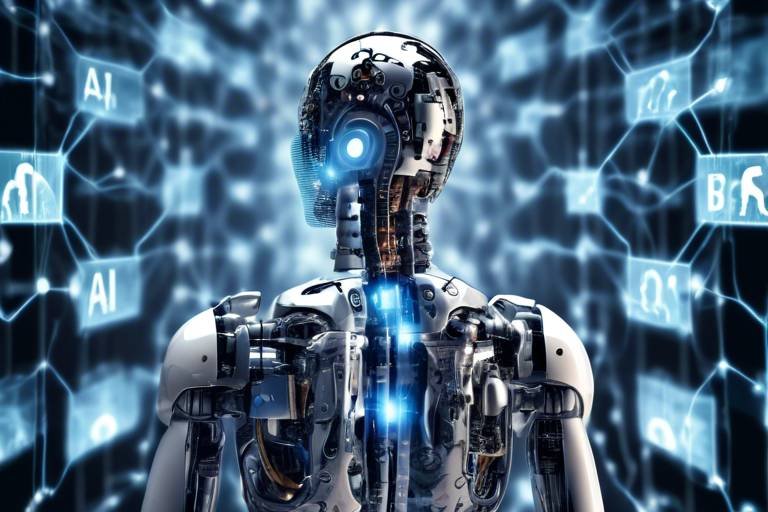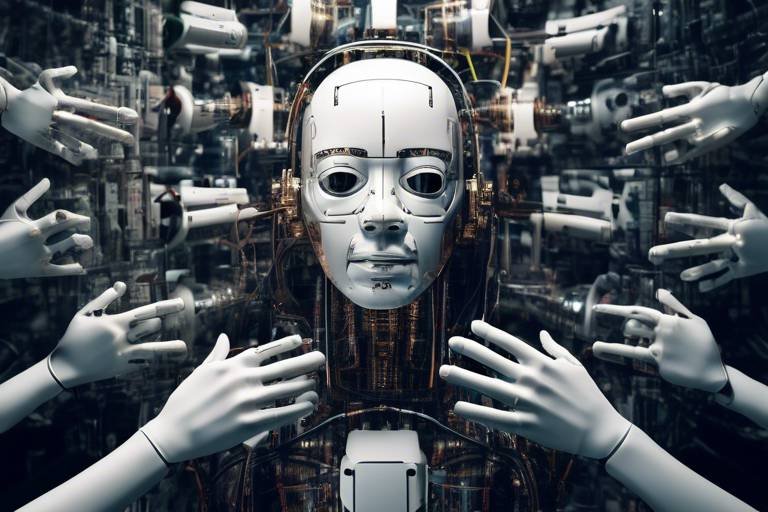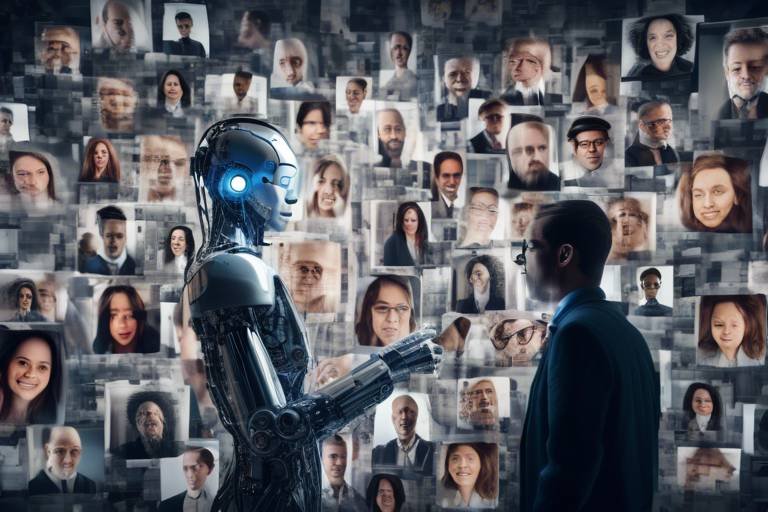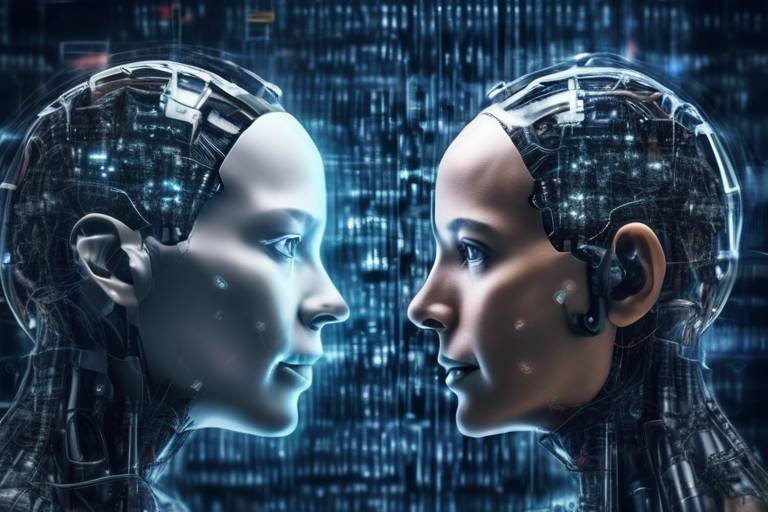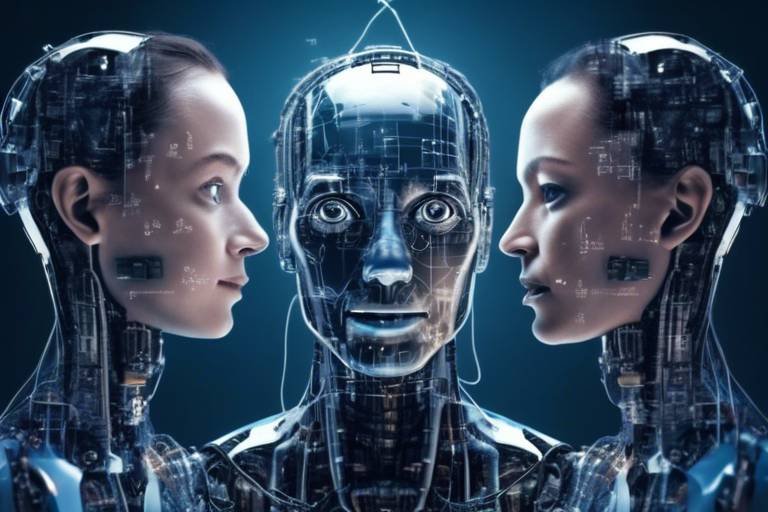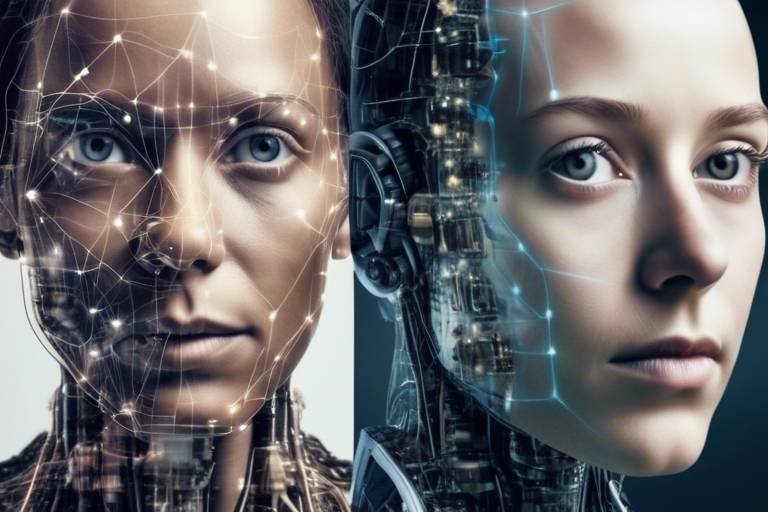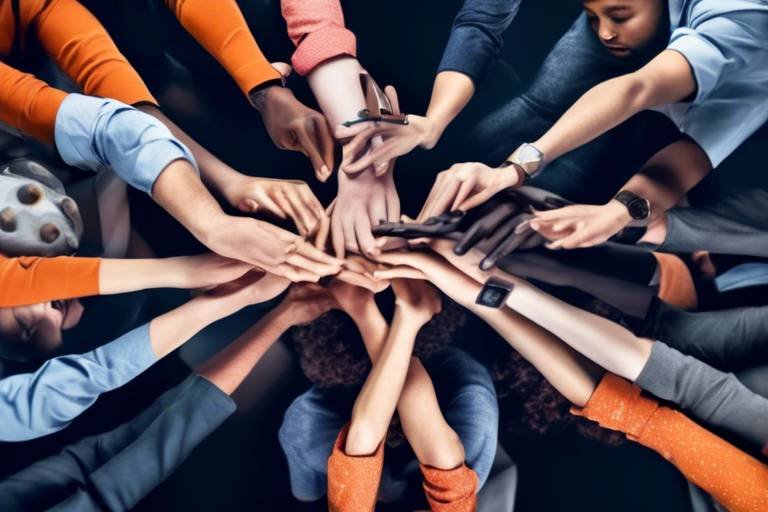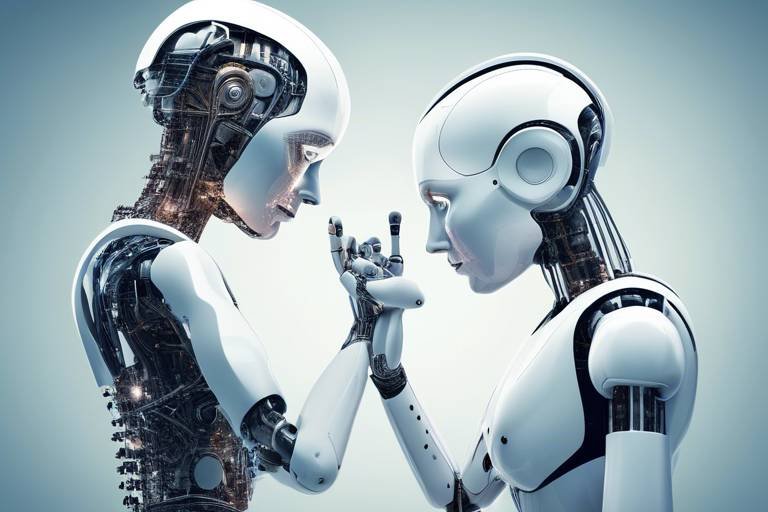How AI is Transforming the Dynamics of Human Collaboration
In today's fast-paced world, the way we collaborate has undergone a dramatic transformation, thanks to the advent of artificial intelligence (AI). Imagine a workplace where your team can communicate seamlessly, make informed decisions in real-time, and work together effectively, regardless of their physical location. Sounds like a dream, right? Well, it’s becoming a reality! AI is not just a buzzword; it is a powerful tool reshaping the landscape of teamwork and productivity.
From enhancing communication to streamlining project management, AI is at the forefront of this revolution. It breaks down barriers, fosters creativity, and empowers teams to achieve their goals more efficiently than ever before. But how exactly is AI making this happen? Let’s dive deeper into the various ways AI is transforming human collaboration.
To truly appreciate the profound impact of AI on collaboration, it's essential to understand its evolution. AI has come a long way since its inception. Early developments in the 1950s and 60s laid the groundwork for what we now consider modern AI. Fast forward to the 21st century, and we see key milestones such as the rise of machine learning, natural language processing, and deep learning, which have all contributed to AI's capabilities in collaborative environments.
These advancements have not only made AI more accessible but have also paved the way for innovative tools that facilitate teamwork. The integration of AI into everyday work processes is no longer a futuristic concept; it’s happening now, and it’s changing the way we interact and collaborate.
One of the most significant areas where AI is making waves is in communication. AI-driven platforms like Slack, Microsoft Teams, and Zoom are revolutionizing how teams interact. These tools come equipped with features that enhance collaboration, such as:
- Real-time translation: Breaking down language barriers to ensure everyone is on the same page.
- Smart scheduling: AI can analyze team members' calendars to find optimal meeting times.
- Automated reminders: Keeping everyone accountable and informed about deadlines.
These features not only save time but also foster a culture of collaboration, enabling teams to focus on what truly matters—achieving their objectives.
When it comes to decision-making, AI’s ability to analyze vast amounts of data is a game-changer. Imagine trying to make a crucial business decision without the right information at your fingertips. AI tools can sift through data, identify patterns, and provide actionable insights that assist teams in evaluating options. This capability allows for more informed, collaborative decision-making processes.
For instance, AI can help teams assess the potential outcomes of various strategies, allowing them to choose the best path forward. By leveraging data analytics, teams can make decisions that are not just instinctive but are backed by solid evidence, leading to better results.
With the rise of remote work, the need for effective collaboration tools has never been greater. AI technologies are stepping up to the plate, ensuring that teams remain productive despite physical distances. Virtual assistants and AI-driven project management tools help remote teams stay organized and connected.
Consider platforms like Trello and Asana, which utilize AI to automate task assignments based on team members' workloads and performance history. This not only streamlines workflows but also enhances accountability, making it easier for teams to collaborate effectively, no matter where they are located.
Project management is another area where AI is making significant strides. AI tools are automating mundane tasks, tracking progress, and providing insights that help teams stay on course. For example, AI can analyze previous project data to predict potential roadblocks and suggest solutions before issues arise.
This predictive capability allows teams to focus on collaboration rather than getting bogged down in administrative tasks. By automating repetitive processes, AI enables team members to dedicate more time to creative problem-solving and innovation.
As we embrace AI in collaboration, we must also address the ethical considerations that come with it. Issues such as data privacy, bias in AI algorithms, and the implications for human interaction are critical to consider. Teams need to establish guidelines that ensure AI is used responsibly and ethically, fostering a collaborative environment that respects individual rights.
Looking ahead, the future of AI in collaboration is bright. Emerging trends such as augmented reality (AR), virtual reality (VR), and more sophisticated AI algorithms promise to further enhance teamwork. These innovations could create immersive collaborative environments that transcend geographical limitations, allowing teams to work together as if they were in the same room.
To illustrate the practical benefits of AI in collaboration, let’s look at some real-world examples. Companies like Google and Microsoft have successfully integrated AI into their collaboration tools, resulting in increased productivity and improved team dynamics. These case studies showcase how organizations harness AI to overcome challenges and achieve their goals.
Q: How does AI improve communication among team members?
A: AI improves communication by offering real-time translation, smart scheduling, and automated reminders, making it easier for teams to stay connected.
Q: Can AI help with decision-making?
A: Yes, AI analyzes data to provide insights that assist teams in making informed decisions, enhancing the collaborative decision-making process.
Q: What are the ethical concerns related to AI in collaboration?
A: Key concerns include data privacy, bias in AI algorithms, and the impact on human interaction, which require careful consideration and guidelines.
Q: What future trends can we expect in AI collaboration?
A: Future trends include the integration of augmented and virtual reality, leading to more immersive and effective collaboration experiences.

The Evolution of AI in Collaboration
The journey of artificial intelligence in the realm of collaboration is nothing short of fascinating. To truly appreciate its current capabilities, we must take a step back and explore the historical context of AI development. From its nascent stages in the mid-20th century to the sophisticated systems we have today, AI has undergone a remarkable transformation. Initially, AI was merely a theoretical concept, with early pioneers like Alan Turing laying the groundwork for what would become a revolutionary field.
Fast forward to the 1980s and 1990s, when AI began to find its footing in practical applications. The introduction of expert systems allowed organizations to leverage AI for decision-making processes, albeit in a limited capacity. These systems could mimic human expertise in specific domains, providing valuable insights but lacking the flexibility and adaptability we see in modern AI technologies. However, the real game-changer came with the advent of the internet and the exponential growth of data in the 2000s. This era marked the beginning of a new chapter, where AI could analyze vast amounts of information and learn from it.
Today, AI is an integral part of our collaborative efforts across various sectors. It has evolved from being a mere tool to becoming a partner in the collaborative process. For instance, AI algorithms can now identify patterns in team interactions, suggesting optimal ways to communicate and collaborate. This shift has redefined the dynamics of teamwork, making collaboration not only more efficient but also more intuitive. As we delve deeper into the specifics of AI's role in enhancing collaboration, it's crucial to recognize these key milestones:
- Machine Learning: The ability of AI to learn from data has revolutionized how teams approach problem-solving.
- Natural Language Processing: This technology enables machines to understand and respond to human language, facilitating smoother communication.
- Cloud Computing: The rise of cloud-based AI solutions has made collaboration tools accessible from anywhere in the world.
Moreover, the integration of collaborative AI tools has made it possible for teams to work together in real-time, regardless of their physical locations. These advancements have not only improved productivity but also fostered a sense of community among remote team members. As we look back at the evolution of AI, it's clear that the path has been paved with innovation and a relentless pursuit of enhancing human collaboration.
In conclusion, understanding the evolution of AI in collaboration allows us to appreciate the profound impact it has on our work environments today. From early computational models to sophisticated AI-driven communication platforms, the journey has been transformative. As we continue to explore the interplay between AI and collaboration, the future holds exciting possibilities that promise to further enhance our teamwork and productivity.

AI-Powered Communication Tools
In today's fast-paced work environment, effective communication is the bedrock of successful teamwork. Enter , the game-changers that are transforming how we interact and collaborate. Imagine a world where your digital assistant not only schedules meetings but also analyzes your team's communication patterns to suggest the best times for collaboration. Sounds futuristic? Well, it's happening right now!
These tools leverage artificial intelligence to enhance connectivity and streamline communication across various platforms. Whether you’re in a cozy café or a bustling office, AI tools ensure that everyone is on the same page. For instance, platforms like Slack and Microsoft Teams utilize AI to provide smart replies, automate mundane tasks, and even prioritize messages based on urgency. This means less time sifting through emails and more time focusing on what really matters—your projects.
Moreover, AI communication tools are designed to break down geographical barriers. With features like real-time translation and transcription, teams from different corners of the globe can collaborate as if they were in the same room. Imagine discussing a project with a colleague in Tokyo while another team member in New York joins the conversation—all while AI translates and transcribes the dialogue seamlessly. This is not just a dream; it's the new reality of remote collaboration.
Let's take a closer look at some features that make these AI tools indispensable:
- Smart Scheduling: AI algorithms analyze calendars to find optimal meeting times, accommodating different time zones and preferences.
- Contextual Insights: Some tools provide insights based on previous conversations, helping teams to stay aligned and informed.
- Sentiment Analysis: AI can gauge the tone of conversations, allowing teams to address potential misunderstandings before they escalate.
As we continue to explore the impact of AI on communication, it’s essential to recognize that these tools are not just about efficiency; they also foster a sense of community. By automating routine tasks, AI allows team members to focus on building relationships and brainstorming innovative ideas. Think of it as having a personal assistant who not only organizes your schedule but also understands your team's dynamics and helps nurture a collaborative spirit.
In conclusion, AI-powered communication tools are revolutionizing the way we connect. They enhance productivity, bridge gaps, and foster a collaborative environment that transcends physical limitations. As these technologies continue to evolve, we can only imagine the endless possibilities they will bring to teamwork and communication.
Q: How do AI communication tools improve team productivity?
A: By automating routine tasks, providing real-time insights, and facilitating seamless communication, AI tools allow teams to focus on more strategic initiatives, thus enhancing overall productivity.
Q: Are AI communication tools suitable for small businesses?
A: Absolutely! Many AI tools are designed to cater to businesses of all sizes, offering scalable solutions that can grow with your team.
Q: What are some popular AI-powered communication tools?
A: Some widely used tools include Slack, Microsoft Teams, Zoom, and Google Workspace, all of which incorporate AI features to enhance communication.

Enhancing Decision-Making with AI
In today's fast-paced world, making informed decisions can feel like trying to find a needle in a haystack. With the sheer volume of data available, it’s easy to get overwhelmed. This is where artificial intelligence steps in, acting like a trusty compass guiding teams through the fog of information. AI's ability to analyze vast datasets quickly and accurately is transforming how teams make decisions, ensuring that they not only make choices faster but also with greater confidence.
Imagine you're part of a team tasked with launching a new product. Traditionally, gathering all the necessary data—market trends, customer preferences, and competitor analysis—could take weeks or even months. However, with AI-powered tools, this data can be aggregated and analyzed in real-time. For instance, AI algorithms can sift through social media sentiment, customer feedback, and sales data to provide actionable insights. This means your team can pivot strategies based on data-driven recommendations rather than relying solely on gut feelings or outdated information.
Moreover, AI doesn’t just crunch numbers; it also identifies patterns that might not be immediately obvious to human analysts. For example, through machine learning, AI can uncover hidden correlations in data, such as a specific demographic that is more likely to purchase a product during a particular season. By leveraging these insights, teams can tailor their marketing strategies or product features to better meet customer needs, ultimately driving sales and enhancing customer satisfaction.
One of the most significant advantages of AI in decision-making is its capacity for predictive analytics. By analyzing historical data, AI can forecast future trends and outcomes. This allows teams to make proactive decisions rather than reactive ones. For instance, if an AI system predicts a drop in sales for a specific product line, the team can address the issue before it escalates, perhaps by adjusting marketing strategies or enhancing product features.
To illustrate the impact of AI on decision-making, consider the following table highlighting key AI-driven decision-making tools and their features:
| Tool | Features | Benefits |
|---|---|---|
| IBM Watson | Natural Language Processing, Predictive Analytics | Data-driven insights, Enhanced customer engagement |
| Google Cloud AI | Machine Learning, Image and Speech Recognition | Automated data processing, Real-time analysis |
| Tableau | Data Visualization, AI-Powered Analytics | Intuitive dashboards, Better decision clarity |
However, while AI tools enhance decision-making capabilities, it’s essential to remember that they are not infallible. Human oversight remains crucial. AI can provide recommendations based on data, but it’s up to the team to interpret these insights within the broader context of their industry, organizational culture, and specific goals. This partnership between AI and human intelligence creates a powerful synergy that can lead to innovative solutions and improved outcomes.
In conclusion, AI is not just a tool for automating mundane tasks; it is a game-changer in the realm of decision-making. By harnessing the power of AI, teams can make faster, more informed decisions that drive success. As we continue to explore the possibilities of AI in collaboration, one thing is clear: the future of decision-making is bright, and it’s powered by artificial intelligence.
- How does AI improve decision-making? AI improves decision-making by analyzing large datasets quickly, identifying patterns, and providing predictive insights that help teams make informed choices.
- Can AI replace human decision-making? While AI can enhance decision-making, it cannot replace the human element. Human oversight and contextual understanding are essential for interpreting AI-generated insights.
- What are some popular AI tools for decision-making? Some popular AI tools include IBM Watson, Google Cloud AI, and Tableau, each offering unique features to assist in data analysis and visualization.

AI and Remote Collaboration
In today's fast-paced world, the concept of work has undergone a seismic shift, especially with the rise of remote collaboration. As more teams operate from different corners of the globe, artificial intelligence has emerged as a vital ally in maintaining productivity and fostering effective communication. Imagine trying to navigate a maze blindfolded; that’s what remote work can feel like without the right tools. AI acts as the guiding light, helping teams stay connected and engaged no matter where they are located.
One of the most significant advantages of AI in remote collaboration is its ability to facilitate real-time communication. Tools such as Slack, Microsoft Teams, and Zoom have integrated AI features that enhance user experience. For example, AI can provide real-time language translation, making it easier for teams from diverse linguistic backgrounds to collaborate without barriers. Furthermore, AI-driven chatbots can assist in answering common queries, allowing team members to focus on more complex tasks. This not only saves time but also reduces the chances of miscommunication.
Moreover, AI plays a crucial role in scheduling and project management. Tools like Trello and Asana utilize AI algorithms to prioritize tasks based on deadlines and team availability. This means that when you log in to check your tasks for the day, AI has already done the heavy lifting for you. It helps in organizing your workload in a way that maximizes efficiency. Imagine having a personal assistant who knows your preferences and work habits; that’s the kind of support AI provides.
Another area where AI shines is in monitoring productivity. AI tools can track the amount of time spent on various tasks and provide insights that help teams understand their work patterns. This data can be invaluable for identifying bottlenecks or areas for improvement. For instance, if a team notices that a particular project consistently takes longer than expected, AI can analyze the workflow and suggest adjustments. This proactive approach not only enhances productivity but also fosters a culture of continuous improvement.
However, the integration of AI in remote collaboration is not without its challenges. As teams become increasingly reliant on AI tools, there are concerns about data privacy and security. Companies must ensure that sensitive information is protected, especially when using cloud-based platforms. Additionally, there’s the risk of over-reliance on technology, which can lead to a decline in interpersonal skills among team members. Striking a balance between utilizing AI and nurturing human connections is essential for successful remote collaboration.
In conclusion, AI has revolutionized the way remote teams collaborate. By enhancing communication, streamlining project management, and providing valuable insights, AI enables teams to work more efficiently and effectively, regardless of their physical locations. As we continue to embrace remote work, the role of AI will only grow, making it an indispensable part of our collaborative toolkit.
- How does AI improve communication in remote teams?
AI enhances communication through real-time translation, chatbots for answering common queries, and smart notifications that keep everyone informed. - What are some AI tools that aid remote collaboration?
Popular tools include Slack, Microsoft Teams, Trello, and Asana, all of which incorporate AI features to optimize workflow. - Are there any risks associated with using AI in remote collaboration?
Yes, risks include data privacy concerns and the potential for over-reliance on technology, which can impact interpersonal skills. - How can teams ensure a balance between AI use and human interaction?
Teams can schedule regular check-ins, encourage open communication, and foster team-building activities to maintain strong interpersonal relationships.

AI in Project Management
When we think about project management, we often envision a whirlwind of deadlines, tasks, and team meetings. But what if I told you that artificial intelligence is here to streamline that chaos? Yes, AI is not just a buzzword; it’s a game-changer in how we manage projects. With the ability to automate mundane tasks and provide insightful analytics, AI tools are transforming project management into a more efficient and collaborative experience.
Imagine a world where your project management software could predict potential bottlenecks before they even occur. That’s the power of AI! By analyzing historical data and current project metrics, AI can forecast challenges, allowing teams to proactively address issues before they escalate. This predictive capability not only saves time but also enhances the overall productivity of the team.
One of the most exciting aspects of AI in project management is its ability to automate repetitive tasks. Think about all those hours spent on scheduling meetings, sending reminders, or updating task statuses. With AI, these tasks can be automated, freeing up valuable time for project managers and team members to focus on more strategic activities. For instance, AI tools can automatically assign tasks based on team members' availability and expertise, ensuring that the right person is on the job.
Furthermore, AI enhances collaboration by providing real-time updates and insights. Imagine being part of a project team where everyone is always on the same page, regardless of their location. AI-powered platforms can facilitate this by offering features like live dashboards and collaborative workspaces. These tools enable team members to track progress, share feedback, and make decisions collectively, fostering a sense of unity and purpose.
To illustrate how AI is revolutionizing project management, let’s take a look at some key features offered by popular AI tools:
| AI Tool | Key Features |
|---|---|
| Trello | Task automation, deadline reminders, and project tracking |
| Asana | Smart project templates, workload management, and progress visualization |
| Monday.com | Customizable workflows, integration with other tools, and real-time collaboration |
These tools not only enhance productivity but also promote accountability among team members. With clear visibility into who is responsible for what, teams can work more cohesively. Additionally, AI can analyze team performance data and provide insights into areas for improvement, making it easier to refine processes and enhance collaboration.
However, it's essential to approach AI in project management with a balanced perspective. While the benefits are substantial, teams must also consider the ethical implications. Issues like data privacy and bias in AI algorithms can pose challenges that need to be addressed. It’s crucial to ensure that AI tools are used responsibly and that they complement human efforts rather than replace them.
In conclusion, the integration of AI into project management is not just a trend; it’s a transformative shift that empowers teams to work smarter, not harder. By automating tasks, enhancing collaboration, and providing valuable insights, AI is paving the way for a more efficient and productive future in project management. As we continue to embrace these technologies, the question remains: how will we harness AI's full potential to improve our collaborative efforts?
- How can AI improve project management? AI can automate repetitive tasks, provide predictive analytics, and enhance team collaboration.
- What are some popular AI tools for project management? Tools like Trello, Asana, and Monday.com offer AI features to streamline project workflows.
- Are there any ethical concerns with using AI in project management? Yes, issues like data privacy and algorithmic bias should be considered when implementing AI solutions.

Ethical Considerations in AI Collaboration
As we dive deeper into the world of artificial intelligence (AI) and its integration into human collaboration, it's crucial to pause and reflect on the ethical implications that accompany this technological evolution. While AI has the potential to enhance teamwork and boost productivity, it also raises significant concerns that we must address to ensure a responsible and equitable future.
One of the primary ethical considerations revolves around data privacy. AI systems often require vast amounts of data to function effectively, which can include sensitive information about individuals and organizations. When teams collaborate using AI tools, they must be vigilant about how this data is collected, stored, and used. Are we adequately protecting personal information, or are we inadvertently exposing ourselves to data breaches? Organizations need to implement robust privacy policies and ensure that team members are aware of their rights concerning data usage.
Another pressing issue is the potential for bias in AI algorithms. AI systems learn from historical data, and if this data contains biases, the AI can perpetuate and even amplify these biases in decision-making processes. For example, if an AI tool is used to evaluate employee performance based on biased historical data, it may unfairly disadvantage certain groups. To combat this, teams must actively work to identify and mitigate biases in their AI systems, ensuring that the technology serves all members of the team fairly.
Moreover, the integration of AI into collaborative settings raises questions about human interaction. As we rely more on AI-driven tools, there's a risk that we may lose the personal touch that is essential for effective teamwork. Collaboration is not just about exchanging information; it’s also about building relationships, understanding emotions, and fostering creativity. How can we ensure that AI enhances rather than diminishes these vital human elements? Striking a balance between leveraging AI for efficiency and maintaining genuine human connections is a challenge that organizations must navigate.
To summarize, the ethical considerations in AI collaboration can be categorized into several key areas:
- Data Privacy: Protecting sensitive information in AI systems.
- Bias in AI: Ensuring fairness in decision-making processes.
- Human Interaction: Maintaining personal connections in the age of AI.
As we move forward, it’s imperative that organizations not only acknowledge these ethical challenges but also take proactive steps to address them. This includes developing clear ethical guidelines for AI use, engaging in ongoing training for team members, and fostering an open dialogue about the implications of AI in collaboration. By doing so, teams can harness the power of AI while upholding the values of fairness, respect, and integrity.
1. What are the main ethical concerns regarding AI in collaboration?
The main concerns include data privacy, bias in AI algorithms, and the impact of AI on human interaction.
2. How can organizations ensure data privacy when using AI tools?
Organizations can implement strict data protection policies, conduct regular audits, and ensure transparency in data usage.
3. What steps can be taken to mitigate bias in AI systems?
Teams can identify and analyze historical data for biases, involve diverse perspectives in the development of AI tools, and continuously monitor AI outputs for fairness.
4. How can we maintain human interaction in AI-driven collaboration?
Organizations can prioritize team-building activities, encourage open communication, and use AI as a tool to enhance, rather than replace, personal connections.

Future Trends in AI and Collaboration
As we look to the horizon, the future of AI and collaboration is not just promising; it’s downright exciting! The rapid evolution of technology means that innovations are constantly reshaping how we work together. Imagine a world where AI not only assists but actively enhances our collaborative efforts. This transformation is not merely a trend; it's becoming the new norm. So, what can we expect in the coming years?
One of the most significant trends on the verge of mainstream adoption is the integration of AI-driven virtual assistants into collaborative platforms. These assistants will be able to schedule meetings, manage tasks, and even provide real-time feedback during discussions. Picture this: you’re in a brainstorming session, and your AI assistant suggests relevant data points or reminds you of previous decisions. This kind of seamless integration will streamline communication and ensure that everyone is on the same page, enhancing productivity and creativity.
Furthermore, we can anticipate a surge in the use of natural language processing (NLP) technologies. These advancements will allow AI systems to understand and interpret human language more effectively. As a result, communication barriers will diminish, making it easier for teams spread across different regions to collaborate as if they were in the same room. Imagine a multinational team working on a project where language differences are no longer a hurdle. This will not only foster inclusivity but also lead to richer collaboration.
Another exciting trend is the rise of predictive analytics. AI will analyze past collaboration patterns to forecast future behaviors and outcomes. Teams will be able to leverage this data to make informed decisions about project timelines, resource allocations, and team dynamics. This proactive approach to collaboration will empower teams to tackle challenges before they arise, enhancing overall efficiency. For instance, if a project is likely to face delays based on historical data, teams can adjust their strategies in advance, avoiding common pitfalls.
Moreover, as remote work becomes a permanent fixture in many industries, the demand for AI-enhanced remote collaboration tools will grow. These tools will not only facilitate communication but also provide insights into team engagement and productivity levels. Imagine a dashboard that uses AI to analyze how often team members interact, their response times, and even their emotional tones during discussions. This data can help managers identify potential issues and foster a more cohesive team environment.
Lastly, we cannot overlook the importance of ethical AI in collaboration. As AI tools become more integrated into our work processes, ensuring that they are designed and implemented ethically will be crucial. This includes addressing concerns about bias in AI algorithms and ensuring data privacy. Future collaborations will not only focus on efficiency and productivity but also on maintaining trust and transparency among team members. Organizations that prioritize ethical considerations will likely foster stronger, more resilient teams.
In summary, the future of AI in collaboration is bright and filled with potential. From AI-driven virtual assistants to predictive analytics and ethical considerations, these advancements will redefine how we work together. As we embrace these changes, it’s essential to remain adaptable and open to new ways of collaborating. The question is not whether AI will change our collaborative efforts, but rather how we will harness its power to create a more connected and productive workplace.
- How will AI change team dynamics? AI will enhance communication, streamline workflows, and provide insights that help teams work more effectively together.
- What are some examples of AI collaboration tools? Tools like Slack, Microsoft Teams, and Asana are incorporating AI features to improve user experience and productivity.
- Are there risks associated with using AI in collaboration? Yes, there are ethical concerns, including data privacy and algorithmic bias, that organizations must address to ensure responsible use of AI.
- Will AI replace human collaboration? No, AI is designed to augment human collaboration, not replace it. The human element remains crucial in teamwork.

Case Studies: Successful AI Implementations
When we talk about the transformative power of artificial intelligence in collaboration, it’s not just theory; there are real-world examples that demonstrate its effectiveness. Companies across various industries are leveraging AI to enhance teamwork and productivity, and the results are nothing short of remarkable. Let’s dive into a few case studies that highlight successful AI implementations in collaborative environments.
One standout example comes from Slack, a platform that has revolutionized workplace communication. By integrating AI-driven features like Smart Replies and Search Suggestions, Slack has significantly improved how teams interact. These features analyze past conversations and suggest relevant responses or documents, making it easier for team members to communicate efficiently. Imagine trying to find an important document in a sea of messages; AI helps pinpoint it in seconds, saving time and reducing frustration.
IBM is another titan that showcases the power of AI in collaboration. Their Watson AI technology has been utilized in various sectors, from healthcare to finance. For instance, in healthcare, Watson assists medical teams by analyzing patient data and suggesting treatment options based on the latest research. This not only enhances decision-making but also fosters collaboration among healthcare professionals who can now rely on AI to provide data-driven insights. The ability to share and discuss these insights leads to more informed decisions and better patient outcomes.
In the realm of project management, Trello has incorporated AI features that help teams stay organized and on track. The platform uses AI to analyze project timelines and suggest optimal task assignments based on team members' past performance and availability. This level of automation not only boosts productivity but also encourages collaboration as team members can see who is responsible for what at any given time. With clarity comes accountability, and that’s a game-changer for project teams.
| Company | AI Tool | Impact |
|---|---|---|
| Slack | Smart Replies, Search Suggestions | Improved communication efficiency |
| IBM | Watson AI | Enhanced decision-making in healthcare |
| Trello | AI Task Assignment | Boosted productivity and accountability |
Moreover, Zoom has made strides in remote collaboration by integrating AI to improve video quality and provide real-time transcription services. This means that during virtual meetings, participants can focus on the discussion without worrying about taking notes, as AI captures everything. The transcripts can then be shared with team members who couldn’t attend, ensuring that everyone is on the same page. This kind of inclusivity fosters a collaborative spirit, even when team members are miles apart.
These case studies illustrate just a fraction of how AI is reshaping collaboration in the workplace. By automating mundane tasks and providing valuable insights, AI not only enhances productivity but also strengthens team dynamics. As we continue to witness the evolution of AI technologies, it’s exciting to think about what the future holds for collaboration in various fields.
Q1: How does AI improve team communication?
A1: AI enhances team communication by providing tools that suggest responses, summarize conversations, and even analyze the sentiment of messages, allowing for more effective interactions.
Q2: Can AI help in decision-making?
A2: Absolutely! AI analyzes vast amounts of data to provide insights and recommendations, helping teams make informed decisions quickly and collaboratively.
Q3: Is AI useful for remote teams?
A3: Yes, AI tools facilitate communication and collaboration among remote teams by automating tasks and providing real-time data analysis, ensuring that distance doesn’t hinder productivity.
Frequently Asked Questions
- How is AI changing the way teams collaborate?
AI is revolutionizing teamwork by providing tools that enhance communication, streamline decision-making, and automate repetitive tasks. By analyzing data and offering insights, AI helps teams make informed choices faster and more efficiently, ultimately boosting productivity.
- What are some popular AI-powered communication tools?
There are several AI-driven communication platforms that have gained popularity, including Slack, Microsoft Teams, and Zoom. These tools use AI to improve features like real-time translation, smart scheduling, and automated responses, making collaboration smoother regardless of where team members are located.
- Can AI help with remote collaboration?
Absolutely! With the rise of remote work, AI technologies have become essential for maintaining productivity. They help remote teams stay connected through virtual meetings, project management tools, and collaboration platforms, ensuring that everyone is on the same page despite physical distances.
- How does AI enhance decision-making in teams?
AI enhances decision-making by analyzing large sets of data quickly and accurately. This allows teams to evaluate various options and outcomes, leading to more informed and collaborative decisions. AI tools can highlight trends and insights that might be overlooked, making the decision-making process more effective.
- What ethical concerns should we consider with AI in collaboration?
As AI becomes more integrated into collaborative environments, it's crucial to address ethical concerns such as data privacy, algorithmic bias, and the potential reduction of human interaction. Organizations must ensure that AI tools are used responsibly, promoting fairness and transparency in their applications.
- What future trends can we expect in AI and collaboration?
Looking ahead, we can anticipate innovations such as more advanced AI-driven analytics, enhanced virtual reality collaboration tools, and increased automation in project management. These trends will likely further improve teamwork and productivity, making collaboration even more seamless and efficient.
- Can you provide examples of successful AI implementations in collaboration?
Sure! Many organizations have successfully integrated AI into their collaborative processes. For instance, companies like IBM and Google have utilized AI to enhance their project management capabilities, leading to improved teamwork and goal achievement. These case studies highlight the tangible benefits of AI in fostering collaboration.

